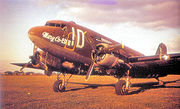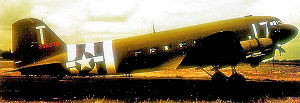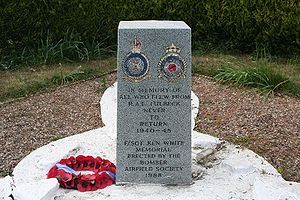
RAF Fulbeck
Encyclopedia


World War II
World War II, or the Second World War , was a global conflict lasting from 1939 to 1945, involving most of the world's nations—including all of the great powers—eventually forming two opposing military alliances: the Allies and the Axis...
airfield in Lincolnshire
Lincolnshire
Lincolnshire is a county in the east of England. It borders Norfolk to the south east, Cambridgeshire to the south, Rutland to the south west, Leicestershire and Nottinghamshire to the west, South Yorkshire to the north west, and the East Riding of Yorkshire to the north. It also borders...
, England
England
England is a country that is part of the United Kingdom. It shares land borders with Scotland to the north and Wales to the west; the Irish Sea is to the north west, the Celtic Sea to the south west, with the North Sea to the east and the English Channel to the south separating it from continental...
. The airfield is located approximately 17 miles (27.4 km) east-northeast of Radcliffe on Trent
Radcliffe on Trent
Radcliffe-on-Trent is a large village and civil parish in the Rushcliffe borough of Nottinghamshire-Location:Radcliffe has a population of around 8,000. It is to the east of Nottingham, and is close to but not quite part of the Greater Nottingham built-up area...
; about 106 miles (170.6 km) north-northwest of London
London
London is the capital city of :England and the :United Kingdom, the largest metropolitan area in the United Kingdom, and the largest urban zone in the European Union by most measures. Located on the River Thames, London has been a major settlement for two millennia, its history going back to its...
Opened in 1940, it was used by both the Royal Air Force
Royal Air Force
The Royal Air Force is the aerial warfare service branch of the British Armed Forces. Formed on 1 April 1918, it is the oldest independent air force in the world...
and United States Army Air Force. During the war it was used primarily as troop carrier airfield for airborne units. After the war it was closed in 1948.
RAF Fullbeck is still used for military training exercises.
Overview
In 1940, meadows six miles east south east of Newark, between the villages of Fenton and Stragglethorpe, were requisitioned for use as a relief landing ground by training aircraft from the RAF College at CranwellCranwell
Cranwell is a village situated in the North Kesteven district of Lincolnshire. It is part of the Civil Parish of Cranwell and Byard's Leap and is located 3.95 miles north-north-west of Sleaford and 16.3 miles south-east of the county town of Lincoln...
. Known unofficially as Fenton, the site continued to serve Cranwell for the next 18 months, gradually collecting a number of huts through the facilities were always basic.
In February 1942, Fenton was scheduled for upgrading to a full-size Class A airfield
Class A airfield
Class A airfields were military installations originally built for the Royal Air Force in the Second World War. Several were transferred to the U.S...
when it was given the official name of Fulbeck after the village 2.5 miles to the east in which parish most of the domestic sites were placed.
The airfield had a set of three converging runways each containing a concrete runway for takeoffs and landings, optimally placed at 60 degree angles to each other in a triangular pattern. The main was 6000 ft (05/23) and two 4200 ft secondary runways aligned 12/30 and 01/19 connecting to an enclosing perimeter track, of a width of 50 feet.
The ground support station was constructed largely of Nissen hut
Nissen hut
A Nissen hut is a prefabricated steel structure made from a half-cylindrical skin of corrugated steel, a variant of which was used extensively during World War II.-Description:...
s of various sizes. The support station was where the group and ground station commanders and squadron headquarters and orderly rooms were located. Also on the ground station were where the mess facilities; chapel; hospital; mission briefing and debriefing; armory; life support; parachute rigging; supply warehouses; station and airfield security; motor pool and the other ground support functions necessary to support the air operations of the group. These facilities were all connected by a network of single path support roads.
The technical site, connected to the ground station and airfield consisted of at least two T-2 type hangars and various organizational, component and field maintenance shops along with the crew chiefs and other personnel necessary to keep the aircraft airworthy and to quickly repair light and moderate battle damage. Aircraft severely damaged in combat were sent to repair depots for major structural repair. The Ammunition dump was located on the south side of the airfield, outside of the perimeter track surrounded by large dirt mounds and concrete storage pens.
Various domestic accommodation sites were constructed dispersed away from the airfield, but within a mile or so of the technical support site, also using clusters of Maycrete or Nissen huts. The Huts were either connected, set up end-to-end or built singly and made of prefabricated corrugated iron with a door and two small windows at the front and back. They provided accommodation for 2.841 personnel, including communal and a sick quarters.
During airborne operations, when large numbers of airborne parachutists were moved to the airfield, tents would be pitched on the interior grass regions of the airfield, or wherever space could be found to accommodate the airborne forces for the short time they would be bivouacked at the station prior to the operation.
USAAF use
In May 1943, a beam approach flight used the airfield but in August Fulbeck was allocated for USAAF Ninth Air ForceNinth Air Force
The Ninth Air Force is a numbered air force of the United States Air Force's Air Combat Command . It is headquartered at Shaw Air Force Base, South Carolina....
use and work commenced to increase accommodation and the number of hardstands, a total of 15 loops being added. Constable Hart & Co. Ltd and F. G. Mintee Ltd were the contractors involved. It was known as USAAF Station AAF-488 for security reasons by the USAAF during the war, and by which it was referred to instead of location. Its USAAF Station Code was "FB".
434th Troop Carrier Group
In October 1943, the 434th Troop Carrier Group434th Air Refueling Wing
The 434th Air Refueling Wing, is one of the key refueling units in the Air Force Reserve. The wing provides mid-air refueling with Boeing KC-135R Stratotankers to long-range bombers, fighters, and cargo aircraft....
arrived at Fulbeck from Baer AAF, Indiana
Indiana
Indiana is a US state, admitted to the United States as the 19th on December 11, 1816. It is located in the Midwestern United States and Great Lakes Region. With 6,483,802 residents, the state is ranked 15th in population and 16th in population density. Indiana is ranked 38th in land area and is...
. The group was assigned to the 53d Troop Carrier Wing and flew Douglas C-47/C-53 Skytrains
C-47 Skytrain
The Douglas C-47 Skytrain or Dakota is a military transport aircraft that was developed from the Douglas DC-3 airliner. It was used extensively by the Allies during World War II and remained in front line operations through the 1950s with a few remaining in operation to this day.-Design and...
. Operational squadrons of the 434th and fuselage codes were:
- 71st Troop Carrier71st Special Operations SquadronThe 71st Special Operations Squadron is part of the 58th Special Operations Wing at Kirtland Air Force Base, New Mexico. It operates CV-22 Osprey conducting special operations flying training.-History:...
(CJ) - 72d Troop Carrier72d Air Refueling SquadronThe 72d Air Refueling Squadron is part of the 434th Air Refueling Wing at Grissom Joint Air Reserve Base, Indiana. It operates the Boeing KC-135 Stratotanker aircraft conducting aerial refueling missions...
(CU) - 73d Troop Carrier73d Airlift SquadronThe 73d Airlift Squadron is part of the 932nd Airlift Wing at Scott Air Force Base, Illinois. It operates C-9 Skytrain II and C-40 Clipper aircraft providing executive airlfit.-Mission:...
(CN) - 74th Troop Carrier74th Air Refueling SquadronThe 74th Air Refueling Squadron is part of the 434th Air Refueling Wing at Grissom Joint Air Reserve Base, Indiana. It operates the KC-135 Stratotanker aircraft conducting aerial refueling missions.-History:...
(ID)
The 434th TCG had 56 C-47s and started training with some detachments elsewhere until finally moving to RAF Welford
RAF Welford
RAF Welford is an active Royal Air Force station in Berkshire, England. The airfield is located approximately northwest of Newbury; about west-southwest of London...
on 10 December 1943.
442d Troop Carrier Group
At the end of March 1944 the 442d Troop Carrier Group442d Fighter Wing
The 442d Fighter Wing is an Air Force Reserve Command fighter wing, operationally-gained by Air Combat Command . It is based at Whiteman Air Force Base in Missouri...
arrived at Fulbeck from Baer AAF, Indiana
Indiana
Indiana is a US state, admitted to the United States as the 19th on December 11, 1816. It is located in the Midwestern United States and Great Lakes Region. With 6,483,802 residents, the state is ranked 15th in population and 16th in population density. Indiana is ranked 38th in land area and is...
. The group was assigned to the 50th Troop Carrier Wing and flew Douglas C-47/C-53 Skytrains
C-47 Skytrain
The Douglas C-47 Skytrain or Dakota is a military transport aircraft that was developed from the Douglas DC-3 airliner. It was used extensively by the Allies during World War II and remained in front line operations through the 1950s with a few remaining in operation to this day.-Design and...
. Operational squadrons of the 442d and fuselage codes were:
- 303d Troop Carrier303d Fighter SquadronThe 303d Fighter Squadron is part of the 442nd Fighter Wing at Whiteman Air Force Base in Missouri. It operates the A-10 Thunderbolt II in conducting close air support missions.-History:...
(J7) - 304th Troop Carrier (V4)
- 305th Troop Carrier (4J)
- 306th Troop Carrier (7H)
The 442d received additional training with C-47's and C-53's at Fulbeck, and later used these aircraft for operations. The group flew the first missions during the invasion of the Continent
D-Day
D-Day is a term often used in military parlance to denote the day on which a combat attack or operation is to be initiated. "D-Day" often represents a variable, designating the day upon which some significant event will occur or has occurred; see Military designation of days and hours for similar...
, dropping paratroops of the U.S. 82nd Airborne and U.S. 101st Airborne Divisions
101st Airborne Division
The 101st Airborne Division—the "Screaming Eagles"—is a U.S. Army modular light infantry division trained for air assault operations. During World War II, it was renowned for its role in Operation Overlord, the D-Day landings on 6 June 1944, in Normandy, France, Operation Market Garden, the...
near Sainte-Mère-Église
Sainte-Mère-Église
Sainte-Mère-Église is a commune in the Manche department in Normandy in north-western France.-History:Founded in the eleventh Century, the earliest records include the name Sancte Marie Ecclesia, Latin for "Church of St. Mary", while a later document written in Norman-French mentions Saincte...
on 6 June 1944 and flying a resupply mission on 7 June, being awarded a Distinguished Unit Citation for its part in the Normandy invasion.
The 442d TCG moved to RAF Weston Zoyland
RAF Weston Zoyland
thumb|C-47s of the 306th Troop Carrier SquadronRAF Station Weston Zoyland is a former World War II airfield in Somerset, England. The airfield is located approximately east-southeast of Bridgwater; about west-southwest of London...
in mid-June after having taken part in the D-Day operations.
440th Troop Carrier Group
During the following two months there was little activity at Fulbeck until some C-47s of the 440th Troop Carrier Group440th Airlift Wing
The 440th Airlift Wing is a United States Air Force Reserve unit assigned to Twenty-Second Air Force. It is stationed at Pope Field, part of Fort Bragg in North Carolina....
arrived in September 1944 from RAF Exeter to use Fulbeck as part of Operation Market, the air component of Operation Market-Garden.
The 440th TCG dropped paratroops of 82nd Airborne Division near Groesbeek
Groesbeek
Groesbeek is a municipality and a town in the eastern Netherlands.-Description:Groesbeek is named after a small stream called the Groesbeek, which in its original form doesn't exist anymore...
Holland on 17 September 1944 and released gliders with reinforcements on 18 and 23 September.
RAF Bomber Command use
The IX Troop Carrier Command relinquished the airfield back to the RAF in late September and No. 5 GroupNo. 5 Group RAF
No. 5 Group was a Royal Air Force bomber group of the Second World War, led during the latter part by AVM Sir Ralph Cochrane.-History:The Group was formed on 1 September 1937 with headquarters at RAF Mildenhall....
Bomber Command moved in the distinguished No. 49 Squadron
No. 49 Squadron RAF
No. 49 Squadron was a bomber squadron of the Royal Air Force from 1938 to 1965. They received their first Hampdens in September 1938.They were a famous Hampden squadron; with the only Victoria Cross awarded Rod Learoyd amongst the ones who served on the type....
from Fiskerton
RAF Fiskerton
RAF Fiskerton was located in the Lincolnshire village of Fiskerton, 5 miles east of Lincoln, Lincolnshire. It was one of many new bomber airfields built in the early part of World War II. The airfield was situated north of the village...
, an airfield which was transferred to No. 1 Group
No. 1 Group RAF
Number 1 Group of the Royal Air Force is one of the two operations groups in Air Command.The group is today referred to as the Air Combat Group, as it controls the RAF's combat fast-jet aircraft and has airfields in the UK plus RAF Unit Goose Bay in Canada, which is used extensively as an...
the following month.
On 2 November the recently-formed No. 189 Squadron
No. 189 Squadron RAF
-History:No. 189 Squadron was formed at Ripon on 20 December 1917 as a night-flying training unit, moving shortly afterwards to Sutton's Farm to continue their work until the end of World War I. On 1 March 1919, the squadron was disbanded....
arrived from Bardney
RAF Bardney
RAF Bardney was a RAF station situated near Bardney, in Lincolnshire, England. It was built as a satellite to RAF Waddington in 1943.-Time line:* Opened on 13 April 1943 as home to No. 9 Squadron...
having taken part in its first operation the previous day. Both Nos. 49 and 189 Squadron's Lancasters remained based at Fulbeck until April 1945. No. 49 flew some 60 raids from the airfield losing 15 aircraft and No. 189 took part in 40 raids with 16 aircraft lost. No. 189 moved back to Bardney on the 8th of the month and No. 49 moved to Syerston
RAF Syerston
RAF Syerston is a Royal Air Force station in the parish of Flintham, near Newark, Nottinghamshire. It was used as a bomber base during World War II.-Bomber Command:...
on the 22nd. On the morning of transfer, a No. 49 Squadron Lancaster making a low farewell pass across the airfield crashed into the technical area and of the resulting 24 casualties among air and ground personnel, 15 were fatal.
Bomber Command operations from Fulbeck cost 38 Lancasters, either failing to return or destroyed in crashes.
Postwar Military use

Retained as a reserve airfield, Fulbeck was also used as a Ministry of Defence
Ministry of Defence (United Kingdom)
The Ministry of Defence is the United Kingdom government department responsible for implementation of government defence policy and is the headquarters of the British Armed Forces....
training area playing host to a number of military exercises. The runways, apart from narrow strips used as farm roads, were removed in the 1970s and all but three of the hardstandings but the perimeter track was kept intact. Small sections of the 30 and 10 runway ends, however, still exist in their full width. At one time Fulbeck was proposed for a nuclear waste disposal site.
RAF Fullbeck is still used for military training exercises and a karting track has now been built over the previous site of the runway.

